
Krishna paintings hold immense significance in Indian art and culture. Depicting the beloved deity Krishna, these artworks have been a source of inspiration and devotion for centuries. Krishna is a central figure in Hindu mythology, revered as the eighth avatar of Lord Vishnu. Known for his divine characteristics, captivating charm, and mischievous nature, Krishna is a beloved figure among Hindus.
Throughout history, artists have beautifully captured the various aspects of Krishna's life and portrayed them through vibrant paintings. These artworks not only showcase artistic skill but also serve as a means of connecting with the divine. Krishna paintings have become an integral part of Indian artistic traditions, contributing to the rich cultural tapestry of the country.
In this blog, we will delve into the symbolism of colours found in Krishna paintings. Colour plays a significant role in art, and it holds even deeper meanings in the context of spiritual and religious depictions. Krishna paintings are often adorned with a plethora of colours, each carrying its own symbolism and conveying a specific mood or message.
By examining the colours used in Krishna paintings, we can unravel the hidden meanings and understand the deeper symbolism behind them. From the vibrant blue of Krishna's complexion to the lush green of the forests where he frolicked, each colour choice carries a unique significance. Exploring the symbolism of colours in Krishna paintings allows us to appreciate the thoughtfulness and intention behind the artist's portrayal of this divine figure.
Join us on this journey as we unravel the intricate world of Krishna paintings, discovering the profound symbolism that lies within the colours used to depict the enchanting tales of Lord Krishna.
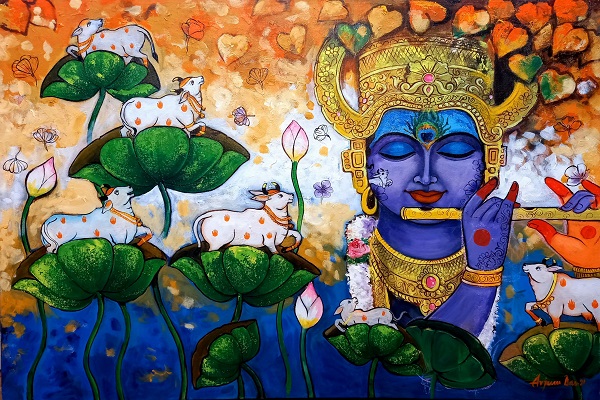
Blue: The Color of Divinity
Krishna is commonly depicted with a bluish complexion, which has deep symbolism in Hindu mythology and Krishna's divine persona. The association of Krishna with the colour blue can be traced back to ancient scriptures and folklore. According to legends, Krishna's skin tone resembled that of a dark raincloud, captivating all who beheld him. This unique complexion has become one of the defining characteristics of Krishna's representation in art.
In Krishna's paintings, the colour blue carries profound symbolic meaning. Blue is often associated with divinity, transcendence, and the infinite. It represents the vastness of the sky, the depths of the ocean, and the boundless expanse of the universe. The colour blue in Krishna paintings signifies the divine nature of Krishna, his eternal presence, and his connection to the spiritual realm.
Blue is also linked to calmness, serenity, and tranquillity. In Krishna's depiction as a young boy, his blue complexion reflects his playful and mischievous nature. It suggests a sense of innocence, joy, and spontaneity that is characteristic of childhood. The colour blue thus adds an element of enchantment and delight to Krishna's portrayal, inviting viewers to embrace the joyful aspects of life.
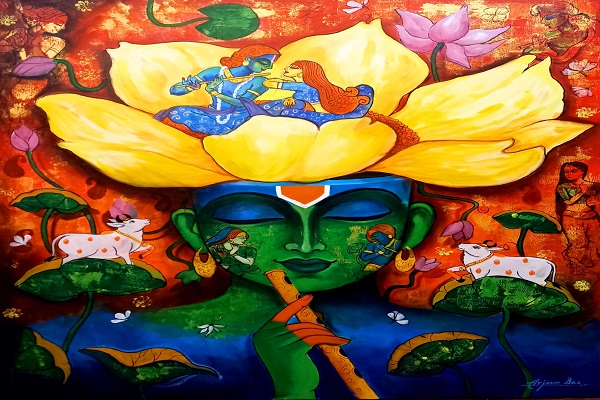
Read More: The Saga of Radha Krishna Paintings - a dive into the past
Yellow: Radiating Joy and Prosperity
In Krishna paintings, yellow prominently appear in the attire worn by Lord Krishna. His garments, such as his dhoti (traditional Indian garment) and angavastram (shoulder cloth), often incorporate shades of yellow or golden hues. This deliberate use of yellow in Krishna's clothing enhances the visual appeal and carries profound symbolism.
The colour yellow holds significant symbolic connotations in relation to Krishna's joyful and prosperous nature. It represents optimism, happiness, and radiance. Yellow is often associated with sunshine, warmth, and the vibrant energy of life. In Krishna paintings, the presence of yellow suggests the divine joy that Krishna brings to the lives of his devotees.
Moreover, yellow is also linked to prosperity and abundance. It is the colour of gold, symbolizing wealth, prosperity, and good fortune. By incorporating yellow into Krishna's attire, the artists symbolically depict his role as a bringer of prosperity and his ability to bestow blessings upon his devotees.
Yellow plays a crucial role in capturing Krishna's playful and charismatic personality. The vibrant yellow hues in his clothing accentuate his youthful charm and magnetic aura. Krishna is known for his mischievous nature and his ability to captivate everyone with his enchanting presence. The colour yellow further enhances these qualities, radiating an aura of charisma, joy, and liveliness.
Additionally, yellow represents creativity and intellect. Krishna, in his various roles as a philosopher, musician, and poet, embodies these qualities. The use of yellow in Krishna's paintings reflects his intellectual prowess, creative expression, and his role as a source of inspiration for artists, scholars, and seekers of knowledge.
In essence, the presence of yellow in Krishna paintings symbolizes joy, radiance, prosperity, and Krishna's playful and charismatic personality. It adds a dynamic and vibrant element to his portrayal, capturing the essence of his divine nature and the positive impact he has on the lives of his devotees.
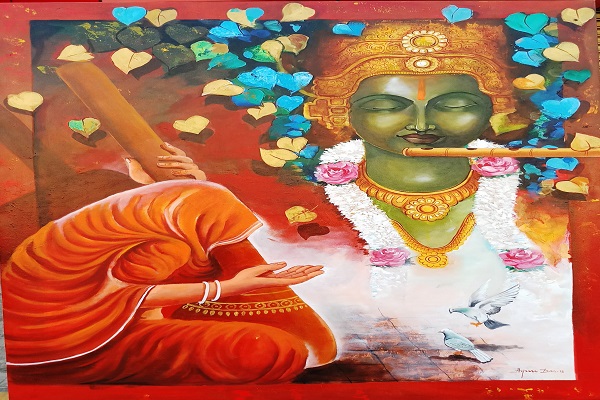
Red: The Colour of Passion and Love
Red is often utilized in Krishna paintings to depict the passionate and romantic relationships, particularly between Krishna and Radha. Radha, often portrayed as Krishna's divine consort and the embodiment of love and devotion, is frequently adorned in vibrant red garments. Red is also seen in the background, as well as in decorative elements, to enhance the depiction of love and passion in Krishna paintings.
The colour red holds powerful symbolic implications when it comes to conveying the passionate and romantic aspect of Krishna's relationships, particularly with Radha. Red represents intense emotions, desire, and love. It embodies the fire of passion and the depth of affection that exists between Krishna and Radha.
In the context of Krishna and Radha's love, red symbolizes the longing, yearning, and intense emotional connection they share. It signifies the fiery passion and romantic ardour that fuels their relationship. Red captures the essence of their divine love and the powerful emotions that bind them together, creating a captivating portrayal of their union.
Red also plays a role in capturing the intensity and depth of Krishna's devotion. Krishna is not only the object of love and adoration but also a fervent devotee himself. In some paintings, Krishna is depicted wearing red attire, highlighting his passionate devotion towards a higher spiritual reality.
The colour red represents the fervour, dedication, and sacrifice that Krishna embodies in his devotion. It symbolizes his unwavering commitment and the burning desire to connect with the divine. Through the use of red, Krishna paintings convey the profound devotion that Krishna inspires in his devotees and his own relentless pursuit of spiritual enlightenment.
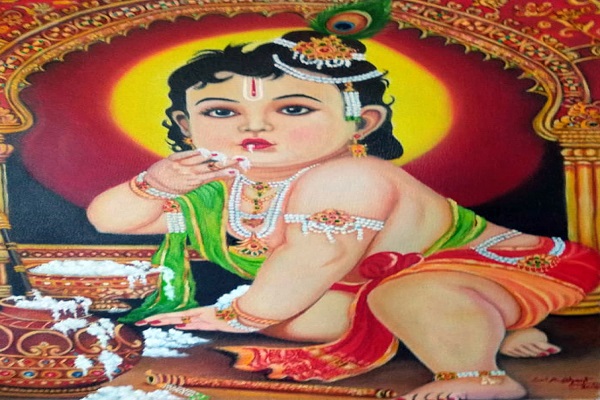
Also Check: 8 Tips for Lighting Radha Krishna Paintings in your Home
Green: Symbolizing Nature and Harmony
Green is a prevalent colour in Krishna paintings, particularly in the depiction of natural landscapes. Krishna is often portrayed amidst lush greenery, surrounded by trees, forests, and gardens. The use of green in these artworks serves to create a vibrant and serene backdrop that enhances the overall visual composition.
Green holds significant symbolic representation in Krishna paintings, reflecting Krishna's deep connection to nature and his role as a protector. Green symbolizes fertility, growth, and rejuvenation. It represents the abundant life force found in nature and signifies Krishna's ability to nurture and sustain life.
Krishna is often depicted as a cowherd, spending his days in the tranquil pastures of Vrindavan, tending to cows and enjoying the company of his devotees. The presence of green in Krishna paintings represents his harmonious relationship with the natural world. It showcases his role as a caretaker of the environment and a protector of all living beings.
Green also signifies harmony and balance in Krishna's divine presence. It represents the harmonious coexistence of all elements of creation. Krishna is portrayed as a harmonizing force, bringing balance and order to the universe. The colour green in Krishna paintings embodies the ideal state of equilibrium and interconnectedness that Krishna represents.
Moreover, green is associated with tranquillity and peace. It evokes a sense of serenity and calmness, reflecting Krishna's calming influence and his ability to bring inner peace to his devotees. The green landscapes in Krishna paintings invite viewers to immerse themselves in the soothing embrace of nature and find solace in Krishna's presence.
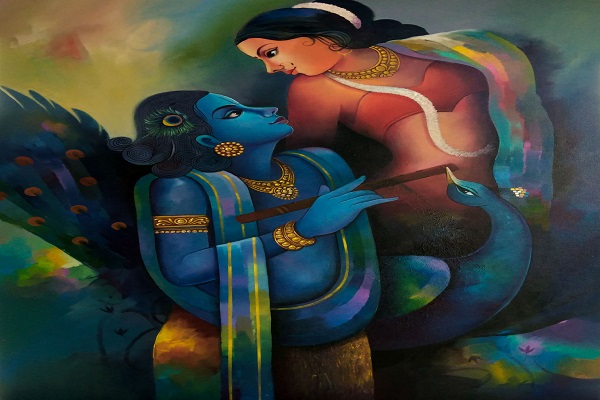
Other Colours and Their Significance
Apart from blue, yellow, and green, Krishna paintings often incorporate other colours such as white, black, and gold. While these colours may not be as prominently used as blue or yellow, they hold their own symbolic significance and contribute to the overall visual narrative.
- White: White represents purity, innocence, and spirituality. In Krishna paintings, white is often seen in the attire worn by Krishna and other divine figures. It symbolizes Krishna's divine purity and his role as a spiritual guide. White also signifies the transcendence of worldly attachments and the attainment of spiritual enlightenment.
- Black: Black is associated with mystery, power, and the infinite. In Krishna paintings, black is used to depict Krishna's hair, which is often portrayed as lustrous and curly. Black represents Krishna's enigmatic nature, his limitless power, and the cosmic energy he embodies. It symbolizes the divine mysteries that Krishna unravels and his ability to transcend boundaries.
- Gold: Gold symbolizes wealth, prosperity, and divine radiance. It is often used to adorn Krishna's ornaments, accessories, and divine halo. Gold represents the divine splendour and majesty of Krishna. It signifies his elevated status as a divine being and his ability to bestow blessings and abundance upon his devotees.
The specific use of these colours in Krishna paintings varies based on the context and artistic interpretation. Each colour adds depth and layers of symbolism to the portrayal of Krishna, enhancing the visual storytelling and conveying specific aspects of his divine nature and the stories associated with him.
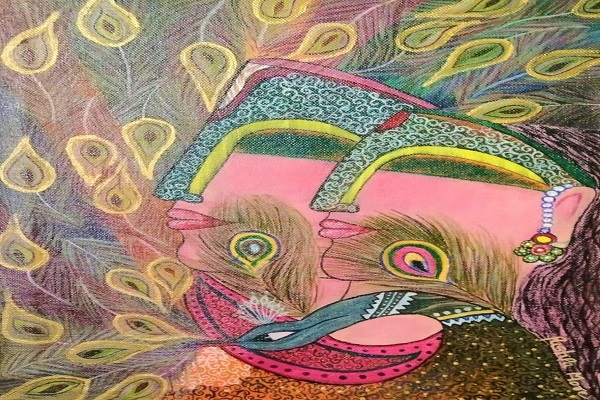
Interesting Blog: Radha & Lord Krishna Paintings: Why You Should Have Them in Your Home
Conclusion
In this blog, we explored the profound symbolism of colours in Krishna paintings, a rich tradition of Indian art. We discussed the significance of blue, representing Krishna's divinity and transcendence. Yellow symbolized joy, prosperity, and Krishna's charismatic personality. Green symbolized nature, harmony, and Krishna's role as a protector. Additionally, we touched upon the meanings of white, black, and gold, representing purity, mystery, and divine radiance respectively.
Krishna paintings showcase a mesmerizing visual language that goes beyond aesthetic beauty. Each colour choice enhances the spiritual narrative, infusing the artwork with layers of meaning. The vibrant hues evoke emotions, capture the essence of Krishna's divine nature, and bring to life the enchanting tales associated with him. The artists' skilful use of colours elevates Krishna art into a visual symphony that resonates with the hearts and minds of viewers.
We invite you to delve deeper into the mesmerizing world of Krishna paintings and appreciate their profound symbolism. Explore the breathtaking artworks, where colours come alive to depict the divine and convey timeless messages. Immerse yourself in the enchanting tales of Krishna's love, joy, and devotion as you unravel the intricate symbolism hidden within each brushstroke.
To further immerse yourself in the captivating world of Indian art and buy paintings online, visit IndianArtIdeas.in. Discover a treasure trove of Krishna paintings and explore the diverse range of artistic expressions. Let the colours and symbolism transport you to a realm where divinity and art merge, inspiring a deeper connection with spirituality and Indian culture.
Unlock the doors to the captivating world of Krishna art and allow it's vibrant colours and profound symbolism to awaken your senses and nourish your soul.





















